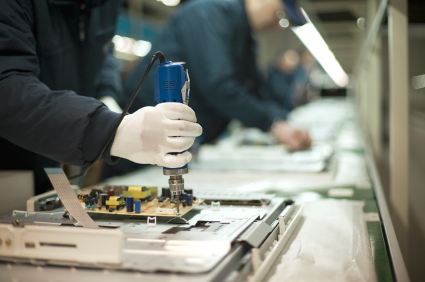***z-above-h1.shtml***
 Technically,
the direct labor employees are the only people in the company that
produce income. They are taking raw materials and converting them into
a useful item that can be sold. All other employees of the company are
important, but all others are supporting the creation of value in the
product or are involved in the sale of the product.
Technically,
the direct labor employees are the only people in the company that
produce income. They are taking raw materials and converting them into
a useful item that can be sold. All other employees of the company are
important, but all others are supporting the creation of value in the
product or are involved in the sale of the product.
Direct Cost per Part:
Most cost systems use a standard cost. For direct labor, the standard cost is the amount per hour the employee earns plus the cost to the employer for employment taxes and benefits.
The standard labor cost per part is calculated by taking the labor cost per hour divided by the parts per hour the employee is able to produce. The standard quantity produced is arrived at by starting with a 60 minute hour and subtracting from this the break times, machine downtime, etc. Then, the amount of parts that can be produced by the machines is determined. With this information, a standard parts produced can be determined. For example:
Collecting labor costs:
Direct employees usually fill out time cards. Either the employee herself or a clerk will enter the time worked and what jobs were worked on. An accurate collection of employee time worked on product provides a wealth of information for analysis.
If the amount of downtime and the reason for the downtime is also collected, then problems can be identified that are causing the downtime and solutions can be implemented.
Information is collected and input into the MRP system. From this system many reports can be run to help management run the company.
Direct Labor
Direct labor is the cost of the person(s) that actually manufactures the product. This person is involved in creating value in the part.
These
employees manufacture or assemble all or part of a product.
Some of the jobs that they will do are:
- Stamp metal parts
- Assemble parts
- Install or insert parts
- Sand or cut
 Technically,
the direct labor employees are the only people in the company that
produce income. They are taking raw materials and converting them into
a useful item that can be sold. All other employees of the company are
important, but all others are supporting the creation of value in the
product or are involved in the sale of the product.
Technically,
the direct labor employees are the only people in the company that
produce income. They are taking raw materials and converting them into
a useful item that can be sold. All other employees of the company are
important, but all others are supporting the creation of value in the
product or are involved in the sale of the product.Direct Cost per Part:
Most cost systems use a standard cost. For direct labor, the standard cost is the amount per hour the employee earns plus the cost to the employer for employment taxes and benefits.
The standard labor cost per part is calculated by taking the labor cost per hour divided by the parts per hour the employee is able to produce. The standard quantity produced is arrived at by starting with a 60 minute hour and subtracting from this the break times, machine downtime, etc. Then, the amount of parts that can be produced by the machines is determined. With this information, a standard parts produced can be determined. For example:
- 60 minutes less 5 minutes for employee break, less machine downtime of 5 minutes = 50 minutes work time.
- The machinery can produce 10 parts in 50 minutes.
- Two employees are required to operate the machinery.
- 50 minutes standard work time per hour divided by 10 pcs per hour = standard run time of 5 minutes per part
- 2 employees at $10 per hour each or $20 per hour total, divided by 60 minutes = $.333 per minute labor cost
- Out part takes 5 minutes to produce, so 5 x $.333 per minute = $1.665 standard direct labor cost per part.
Collecting labor costs:
Direct employees usually fill out time cards. Either the employee herself or a clerk will enter the time worked and what jobs were worked on. An accurate collection of employee time worked on product provides a wealth of information for analysis.
If the amount of downtime and the reason for the downtime is also collected, then problems can be identified that are causing the downtime and solutions can be implemented.
Information is collected and input into the MRP system. From this system many reports can be run to help management run the company.